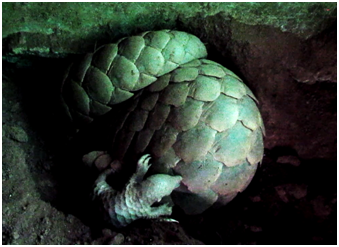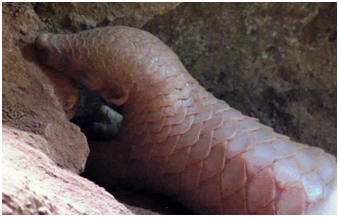eISSN: 2575-906X


Indian pangolin (Manis crassicaudata Gray, 1827) is one of the eight living species of pangolins in the world. They are toothless, nocturnal, burrowing, myrmecophagous mammals and occur throughout peninsular India, Sri Lanka, Bangladesh and Pakistan. Indian pangolins, like all other pangolin species, do not breed readily in captivity. Although births have been reported throughout the year except for May and June, observations on the gestation period of Indian pangolins are limited as mating and subsequent births are seldom observed.1–10 The present communication is based on one observation on the mating and gestation period of Indian pangolin. We observed mating on 25-02-2014 between an adult female Indian pangolin (Microchip ID–00074D5A63, weighing 8.5 kg) and an adult male Indian pangolin (Microchip ID–98102058378, weighing 9.3 kg) at Pangolin Conservation Breeding Center, Nandankanan Zoological Park, Odisha, India. The detailed observation on the mating behavior was described elsewhere.11 The same female was separated and housed alone thereafter and gave birth to a baby pangolin on 03-11-2014. In the present case, the gestation period was 251 days. We are reasonably confident about the accuracy of the gestation period during the present study, as, after observation of one-time mating event on 25-02-2014, the pair was separated and the female was individually housed until the 03-11-2014 when we observed a baby pangolin attempting to crawl over the mother pangolin inside a burrow, with the umbilical cord still attached and watery discharge on mother’s hind legs, as a sign of recent birth (Figure). The pangolin baby measured 25 cm nose tip to tail tip with a 10.5 cm tail and weighed 160 g. The baby was pinkish in color and with soft scales. Tiny hairs were present on the ventral surface of the body whereas long hairs were present on the dorsolaterial sides protruding beyond the scales. Eyes of the baby were closed at birth. The external genitalia of the baby appeared prominent and possible to sex it as male on the very day of birth (Figure 1).



Acharjyo & Misra4 reported the litter size as one and the baby pangolin weighed 235g and measured 30cm in total body length including 12.5cm long tail at birth. Mahmood et al.,11 reported on the basis of questionnaire survey undertaken in Potohar plateau of Pakistan reported that, Indian pangolins breed once a year, usually twins were born between July & October and juvenile pangolins observed during the month of January. Roberts7 stated that Indian pangolin has a litter of one offspring, a gestation period of more than 80 days, and that the species gives birth in November.
None.
Author declares that there is no conflict of interest.

© . This is an open access article distributed under the terms of the, which permits unrestricted use, distribution, and build upon your work non-commercially.